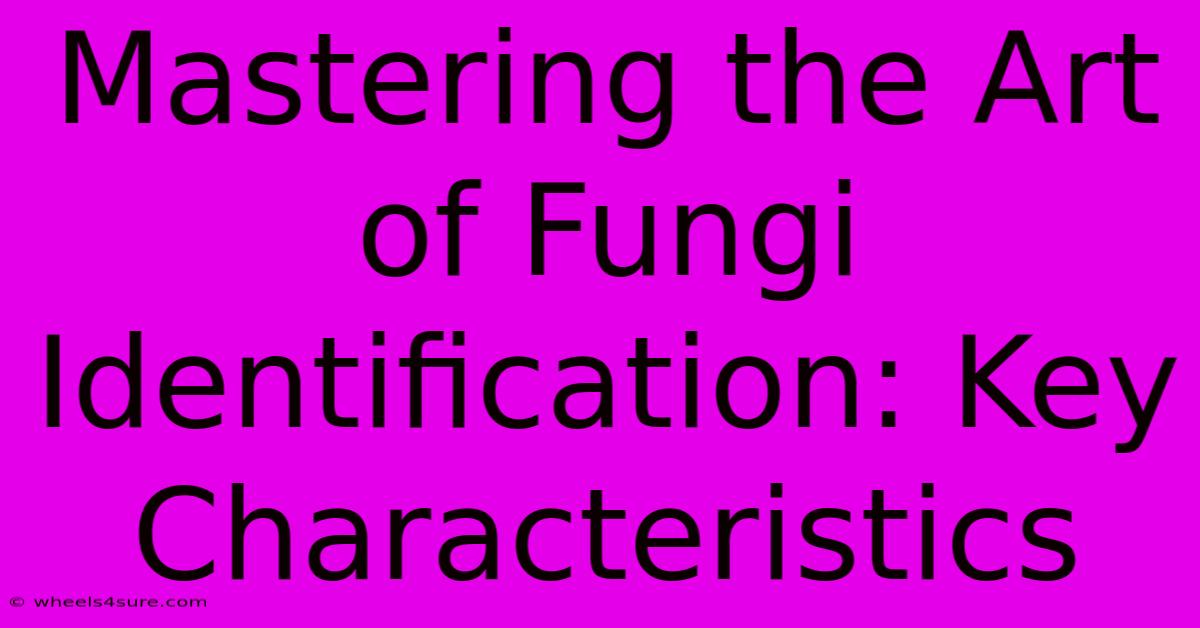Mastering The Art Of Fungi Identification: Key Characteristics

Table of Contents
Mastering the Art of Fungi Identification: Key Characteristics
Foraging for mushrooms is a rewarding hobby, connecting you with nature and providing delicious, nutritious meals. However, safe mushroom foraging relies heavily on accurate identification. Mistaking a poisonous mushroom for an edible one can have serious, even fatal, consequences. This guide delves into the key characteristics you need to master for confident and safe fungi identification.
Beyond the Cap: Essential Characteristics for Fungi Identification
Identifying fungi accurately requires a meticulous approach, going beyond simply looking at the cap. Several crucial characteristics must be considered:
1. Cap (Pileus):
- Shape: Is it convex, flat, concave, or umbonate (with a central bump)? The shape can change as the mushroom matures.
- Size: Note the diameter.
- Color: Describe the color accurately (e.g., "deep reddish-brown," not just "brown"). Consider variations across the cap.
- Surface Texture: Is it smooth, scaly, hairy, sticky, or slimy?
- Margin (Edge): Is it smooth, wavy, striate (with lines radiating from the center), or ragged?
2. Gills (Lamellae):
- Attachment: How do the gills attach to the stem? Are they adnate (attached directly), decurrent (running down the stem), adnexed (nearly attached), or free (not attached)?
- Spacing: Are they close, distant, or crowded?
- Color: Note the gill color and any changes with age.
- Shape: Are they forked or simple?
3. Stem (Stipe):
- Shape: Is it cylindrical, tapered, bulbous, or club-shaped?
- Height and Thickness: Record measurements.
- Color: Observe the color and any variations.
- Surface Texture: Is it smooth, fibrous, scaly, or hairy?
- Ring (Annulus): Is there a ring around the stem? What is its texture and color?
- Volva: Is there a cup-like structure at the base of the stem (a volva)? This is a crucial characteristic for many poisonous Amanita species.
4. Spore Print:
This is one of the most important identification tools. A spore print reveals the color of the mushroom's spores, a key characteristic for many species. To create a spore print:
- Remove the cap from the stem.
- Place the cap, gill-side down, on a piece of white and black paper.
- Cover with a bowl to maintain humidity.
- Leave it undisturbed for several hours or overnight.
- Observe the color of the deposited spores.
5. Habitat and Location:
Where did you find the mushroom? Knowing the type of forest (coniferous, deciduous), the substrate (wood, soil, dung), and the surrounding vegetation can be extremely helpful in identification.
6. Smell and Taste (Use Caution!):
Some mushrooms have distinctive smells and tastes. Never taste a mushroom unless you are absolutely certain of its identity, and even then, only take a tiny amount. Some poisonous mushrooms can cause serious reactions with even small amounts.
7. Microscopic Examination:
For difficult identifications, microscopic examination of the spores and other microscopic structures may be necessary. This often requires specialized equipment and expertise.
Utilizing Resources for Accurate Identification
Accurate identification requires more than just observing these characteristics. You should utilize the following resources:
- Field Guides: Invest in high-quality, reputable field guides specific to your region.
- Mycological Societies: Connect with local mycological societies for expert advice and guided forays.
- Expert Consultation: When in doubt, consult with an experienced mycologist or mushroom expert. Never consume a mushroom if you're unsure of its identity.
Mastering the art of fungi identification is a journey, not a destination. Start with common, easily identifiable species and gradually expand your knowledge. Always prioritize safety, and remember that a single mistake can have severe consequences. Happy foraging!

Thank you for visiting our website wich cover about Mastering The Art Of Fungi Identification: Key Characteristics. We hope the information provided has been useful to you. Feel free to contact us if you have any questions or need further assistance. See you next time and dont miss to bookmark.
Featured Posts
-
Gen X Age Range The Power Of Connection
Apr 04, 2025
-
Flow Gs Net Worth Facts Figures And Future
Apr 04, 2025
-
Rachana Rimal Age An Unexpected Journey
Apr 04, 2025
-
The Power Of Perseverance Sebastian Dobrincus Net Worth
Apr 04, 2025
-
Pharaohs Daughter Facing Her Demons
Apr 04, 2025
